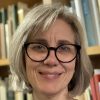Who is Jane Austen?
A guest blog post by Madeline Chanfrau
Madeline is a current M.A. candidate in English at Wake Forest University who earned her B.A. from Davidson College. She is a Graduate Assistant with the University Writing Center and interns at the Wake Forest University Press. Her research interests include feminist and queer studies, Victorian literature, and media studies.

Jane Austen was a British novelist of the Long 18th Century. Who Jane Austen is, however, continued & continues to be decided long past her death in 1817. You may know her novels: Sense & Sensibility, Pride & Prejudice, Mansfield Park, and Emma, as well as Persuasion and Northanger Abbey, which were published posthumously. But, take a moment to ask yourself, what do you know of her?
Prior to Dr. Jessica Richard’s graduate seminar on Jane Austen, I, myself, had a narrowed vision of Jane Austen. I read Northanger Abbey and Pride & Prejudice in high school, and again as undergraduate English major, but my knowledge of the author herself was mostly dependent on the biographical romantic drama, Becoming Jane (2007) and the highly-reproduced engraving commissioned by Austen’s nephew, James Edward Austen-Leigh, for A Memoir of Jane Austen (1870). Clearly, cultural productions of Jane Austen influence who Jane Austen is.

The Special Collections & Archives at Z. Smith Reynolds Library holds several “portraits” of the iconic author, including the first edition Northanger Abbey and Persuasion (published together in four volumes in 1818), which contains Henry Austen’s “Biographical Notice” of his sister. This “Notice” introduces Northanger Abbey and Persuasion, and also introduces Jane Austen to her readers. Previously, the author had remained anonymous. So, who is Jane Austen, here, in 1818?

In the “Notice,” Henry Austen paints a detailed, visual portrait of the author, attributing to her a “complexion of the finest texture” and an “extremely sweet” voice. Is this a prettification, like the “Memoir Portrait”? Undoubtedly, James Andrews’s engraving is the most well-known image of Jane Austen. An unfinished drawing by Jane Austen’s sister, Cassandra, typically dated c. 1810 or 1811, was its inspiration. Here, she sits upright (with crossed arms) and wears an attentive facial expression. Between Cassandra’s drawings and that by James Andrew, what changes?


In both illustrations & biographies of Jane Austen, these differences matter; they illustrate her character. And Henry Austen does so in the “Biographical Notice.” He says, “She never uttered either a hasty, a silly, or a severe expression… She was tranquil without reserve or stiffness; and communicative without intrusion or self-sufficiency.” In short, Henry constructs a moral idealization—one composed of Victorian sentiments about femininity and one that obscures Jane Austen’s literary and publishing motivations; for he also says, “She became an authoress entirely from taste and inclination.”
Unlike Henry’s claim about her authorial intent, Jane Austen could “believe… her good fortune when ‘Sense and Sensibility’ produced a profit,” because in a letter to her brother, Frank, she says, “I have now therefore written myself into £250—which only makes me long for more.” Jane Austen was an accomplished writer and businessperson. Perhaps most funnily, Henry Austen takes pains to assure the readers of Northanger Abbey and Persuasion that “[Jane Austen] drew from nature; but, whatever may have been surmised to the contrary, never from individuals.” If any contemporary reader saw themself in Isabella Thorpe, or perhaps Sir Elliot, no, they did not.

If biographies such as that by Henry Austen paint idealized, romantic portraits of Jane Austen, can we ever really know who she was? The answer, of course, is yes. We know she was a reader of Frances Burney’s; a copy of Camilla (1795) in the ZSR Special Collections & Archives includes Jane Austen’s name on the subscriber list. Below, I have also included some reading recommendations, in which scholars, archivists, and historians display Jane Austen’s confident knowledge of the publishing industry, patronage of circulating libraries, self-critiques about her works (formulated in letters to Cassandra), and even acknowledge the visual/written misrepresentations of the author by Henry, Hollywood, and other such “portraitists.”


So, the next time you find yourself in the biography section of an edition of Pride & Prejudice, or, like me, watching Becoming Jane (2007), ask yourself: How does this representation construct who Jane Austen is, and why? She was not so “unlikely” as some would have you believe.
Recommended Reading
- Fergus, Jan, et al. “The Professional Woman Writer.” The Cambridge Companion to Jane Austen, Cambridge University Press, 1997, pp. 1–11.
- Mulder, Megan. “Pride and Prejudice, by Jane Austen (1813),” ZSR Blog, Rare Book of the Month, 23 January 2013, https://zsr.wfu.edu/2013/pride-and-prejudice-by-jane-austen-1813/.
- Nigro, Jeffrey. “Visualizing Jane Austen and Jane Austen Visualizing,” JASNA, vol. 29, No. 1, Winter 2008, https://jasna.org/persuasions/on-line/vol29no1/nigro.html.
Works Cited
- Austen, Jane, et al. Northanger Abbey: And Persuasion. First edition, John Murray, Albemarle-Street, 1818.
- Austen, Jane. Pride and Prejudice. TOR, 1994.
- Becoming Jane (2007), IMDb. https://www.imdb.com/title/tt0416508/.
- Mulder, Megan. “Pride and Prejudice, by Jane Austen (1813),” ZSR Blog, Rare Book of the Month, 23 January 2013, https://zsr.wfu.edu/2013/pride-and-prejudice-by-jane-austen-1813/.
- “Portraits of Jane Austen,” JASNA, https://jasna.org/austen/more-on-jane-austens-life/portraits/.

3 Comments on ‘Who Is Jane Austen? By Madeline Chanfrau’
This is a wonderful research piece! I enjoyed asking myself the questions you raise about Jane Austen, using Special collections resources. Thank you!
Lovely use of our collection in your post. I enjoyed the pictures of Jane by her sister; I don’t think I’ve ever seen those before!
What a wonderful post, Megan! The materials from Special Collection you highlight are quite impressive.